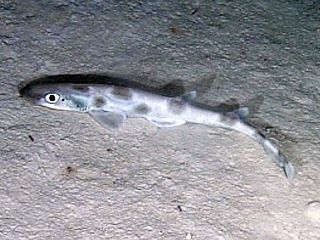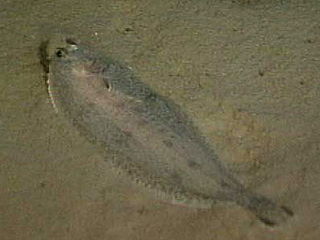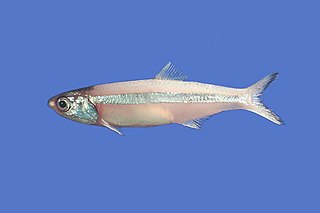
Cod is the common name for the demersal fish genus Gadus, belonging to the family Gadidae. Cod is also used as part of the common name for a number of other fish species, and one species that belongs to genus Gadus is commonly not called cod.

The king mackerel or kingfish, is a migratory species of mackerel of the western Atlantic Ocean and Gulf of Mexico. It is an important species to both the commercial and recreational fishing industries.

Lancetfishes are large oceanic predatory fishes in the genus Alepisaurus in the monogeneric family Alepisauridae.

Peprilus paru,, also occasionally known by a few local names as star butter fish or sometimes even simply as butterfish, is a marine, benthopelagic, circular-shaped and deep-bodied fish classified in the family Stromateidae of butterfishes.

The Atlantic Spanish mackerel is a migratory species of mackerels that swims to the Northern Gulf of Mexico in spring, returns to south Florida in the Eastern Gulf, and to Mexico in the Western Gulf in the fall.
The margined snake eel is a snake eel in the genus Ophichthus. It is found in the coastal waters of the western North Atlantic. It inhabits offshore waters at depths of about 106–154 m (348–505 ft).

The family Stromateidae or butterfish contains 15 species of fish in three genera. Butterfishes live in coastal waters off the Americas, western Africa and in the Indo-Pacific.

The cusk or tusk is a North Atlantic cod-like fish in the ling family Lotidae. It is the only species in the genus Brosme. Its other common names include torsk, European cusk, and brosmius.

The red hake or squirrel hake, Urophycis chuss, is a species of phycid hake. It is found in the Atlantic Ocean at depths between 10 and 500 m. It grows to about 30 in (75 cm) and 7 lb (3.2 kg). Red hake are edible, and are sought out by recreational fisherman as a gamefish.

The roughtail catshark or marbled catshark is a common species of catshark, part of the family Scyliorhinidae. It is found at a depth of 36–702 m (118–2,303 ft) in the northwestern Atlantic Ocean, the Gulf of Mexico, and the Caribbean Sea, from North Carolina to Costa Rica. Individuals of different sexes and ages are segregated to some degree. A small species not exceeding 33 cm (13 in) in length, the roughtail catshark has a slender body with a marbled color pattern of dark saddles and spots, and a prominent crest of enlarged dermal denticles along the dorsal edge of its caudal fin. This species feeds mainly on shrimp and is oviparous. It is caught incidentally in shrimp trawls, though trawl fisheries within its range mostly do not operate at the depths it inhabits. As a result, the International Union for Conservation of Nature has listed it under Least Concern.

The witch, known in English by a variety of other common names including the witch flounder, pole flounder, craig fluke, Torbay sole and grey sole, is a species of flatfish from the family Pleuronectidae. It occurs on both sides of the North Atlantic Ocean on muddy sea beds in quite deep water. In northern Europe it has some importance in fisheries as a food fish.

The marbled grouper, donkey fish, mutton hamlet, rockhind and sicklefish grouper, is a species of marine ray-finned fish, a grouper from the subfamily Epinephelinae which is part of the family Serranidae, which also includes the anthias and sea basses. It is a predatory reef fish which is found in the Western Atlantic Ocean.
The tenspine grouper is a species of marine ray-finned fish, a grouper from the subfamily Epinephelinae which is part of the family Serranidae, which also includes the anthias and sea basses. It is found along the western coast of Mexico and Central America, but is a very rare fish of which little information exists.

Cephalopholis fulva, the coney or the butterfish, is a species of marine ray-finned fish, a grouper from the subfamily Epinephelinae which is in the family Serranidae which also includes the anthias and sea basses. It is found in the western Atlantic. It is associated with reefs and is a quarry species for commercial and recreational fisheries. It can be found in the aquarium trade.

Xanthichthys ringens, the Sargassum triggerfish, is a species of triggerfish from the Western Atlantic, ranging from North Carolina (USA) to Brazil.

Anchoa hepsetus, commonly known as the broad-striped anchovy, is a species of ray-finned fish in the family Engraulidae. It grows to be about 15 cm (6 in) long. The broad-striped anchovy is found in the west Atlantic along the North American coast from Nova Scotia and the Maine coast scarcely, and abundantly from the Chesapeake bay to the West Indies and Uruguay. It is found most commonly in shoals along coastal waters, as deep as 73 m although mostly found water more shallow than this. The broad-striped anchovy spawns in spring. Their eggs are pelagic and hatch within 48 hours at regular spring temperatures. At young ages, it eats copepods, but as the fish ages, its diet begins to consist of other small crustaceans, molluscs, and worm larvae. It is an important food staple for large commercial fishes, such as the American seatrout. It is commonly eaten by birds. It is elongate with large eyes and protuberant snout, large mouth and underslung jaw. Its anal fin is quite short and its front fin lies beneath the end of the dorsal fin. It is grey-green with black dots, but its notable feature is its silvery stripe from head to tail.

Peprilus is a genus of fish in the family Stromateidae found in Pacific and Atlantic Oceans.

The Mediterranean sand smelt, Atherina hepsetus, is a species of fish in the family Atherinidae.
Anchoa mitchilli is a species of ray-finned fish in the family Engraulidae, the anchovies. Its common names include bay anchovy and common anchovy. It is native to the western Atlantic Ocean and Gulf of Mexico. It is one of the most common fish species along the coastlines of the western Atlantic.

The Gulf butterfish is a fish species of the family Stromateidae found in the Gulf of Mexico and off the coast of the Eastern United States.
















